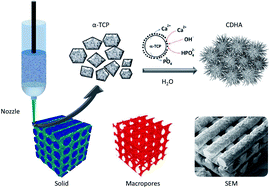Robocasting of biomimetic hydroxyapatite scaffolds using self-setting inks†
Abstract
Low temperature self-setting ceramic inks have been scarcely investigated for solid freeform fabrication processes. This work deals with the robocasting of alpha-tricalcium phosphate/gelatine reactive slurries as a bioinspired self-setting ink for the production of biomimetic hydroxyapatite/gelatine scaffolds. A controlled and totally interconnected pore network of ∼300 μm was obtained after ink printing and setting, with the struts consisting of a micro/nanoporous matrix of needle-shaped calcium deficient hydroxyapatite crystals, with a high specific surface area. Gelatine was effectively retained by chemical crosslinking. The setting reaction of the ink resulted in a significant increase of both the elastic modulus and the compressive strength of the scaffolds, which were within the range of the human trabecular bone. In addition to delaying the onset of the setting reaction, thus providing enough time for printing, gelatine provided the viscoelastic properties to the strands to support their own weight, and additionally enhanced mesenchymal stem cell adhesion and proliferation on the surface of the scaffold. Altogether this new processing approach opens good perspectives for the design of hydroxyapatite scaffolds for bone tissue engineering with enhanced reactivity and resorption rate.


 Please wait while we load your content...
Please wait while we load your content...